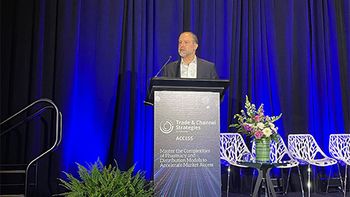
- Pharmaceutical Commerce - July/August 2017
Arxium promotes a ‘Pharmacy 4.0’ perspective on automated compounding
Technology combines automated equipment with workflow and analytic software
Over the past year or so, Arxium (US HQ: Buffalo Grove, IL) has added upgraded software to its RIVA pharmacy-compounding system, which features robotic arms, ISO Class 5 containment of the filling space, and options for vial or syringe packaging and labeling. The Optifill material handling option enables prescription fulfillment on the order of tens of thousands per work shift. Complementary software includes RxWorks Pro, a scheduling and inventory management system. Now, the company is uniting all these capabilities under a “Pharmacy 4.0” theme, which borrows from a manufacturing automation trend, Industry 4.0 (aka the “Smart Factory”). Software will enable better quality control of the filling process, coordination with order management and analytics to monitor and improve overall equipment effectiveness (OEE).
“We’re trying to bring a modern manufacturing and supply chain perspective to central fill pharmacies and pharmacy compounding with Pharmacy 4.0,” says Thomas Doherty, Arxium EVP. “The trend in pharmacy is increasing complexity and increasing volumes in central fill functions, so that it looks more like a manufacturing process taking in ‘raw materials’ and distributing ‘finished goods’ to customers.”
Compounding is widely practiced in the pharmacy community, but it is usually a manual process, and there have been painful lapses in product quality and patient safety, notably the
Compounding is important whenever a drug’s dosage or method of administration (injection, drinkable liquid or other modifications) needs to be adjusted to specific patients. That process has become more critical for the newer biologics and many traditional oncology drugs whose dosage is tied to, for example, the patient’s weight. Doherty says that nearly 50 RIVA systems have been installed in the past nine years, and interest is rising within health systems and integrated delivery networks that have central-fill pharmacies. Routinely, says Doherty, RIVA systems open up already packaged pharmaceuticals (including, it is worth noting, vibration-sensitive monoclonal antibodies) and reconstituting or otherwise manipulating the dosage. There will come a time—not yet—when pharma manufacturers who want to supply health system pharmacies effectively will be designing their containers to fit with RIVA’s automated processing.
Articles in this issue
over 8 years ago
Pharmaceutical traceability stumbles aheadover 8 years ago
Managing employee training at the enterprise levelover 8 years ago
Digital factory transformation beyond serialization complianceover 8 years ago
Blockchain: the technology to make DSCSA work after 2023?over 8 years ago
Besse Medical acquires Podisover 8 years ago
DHL opens a cold-chain center of excellence in Irelandover 8 years ago
Construction starts on a Pfizer biopharma plant near St. Louisover 8 years ago
Looking ahead in life sciences and healthcare logisticsover 8 years ago
Pharma’s cold chain is going below zeroNewsletter
Stay ahead in the life sciences industry with Pharmaceutical Commerce, the latest news, trends, and strategies in drug distribution, commercialization, and market access.





